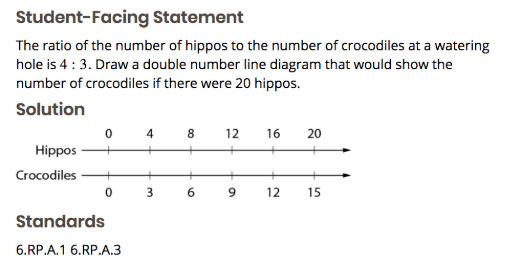There is no shortage of available math resources for teachers to use in their classrooms. The difficult and time-consuming job for teachers is weeding through all of the tools to decide which best supports students in learning mathematics. It is a difficult job because it first involves thinking about how students learn mathematics and then, after choosing a resource, ensure it is being used to best support students’ learning. Our team at Illustrative Mathematics works closely with partners to align their resources with the IM 6–8 Math curriculum so teachers can feel confident using them in their classrooms to support student learning. In aligning these resources, we keep the focus of how students learn mathematics at the forefront, while considering the type of support the additional resource is providing.
Learning Math by Doing Math
We know students learn mathematics by doing mathematics and that a coherent, problem-based curriculum supports teachers and students in this work. The value of a problem-based approach is that students spend most of their time in math class doing mathematics: making sense of problems, trying different approaches, selecting and using appropriate tools, noticing patterns and making generalizations, explaining their reasoning, listening to others, and building understanding. We also know that classrooms are usually made up of students at different points in their learning trajectory, and different students need different amounts of practice to really master the ideas they have learned.
Practice in the IM 6–8 Math Curriculum
If you do a search for the word practice in the IM 6–8 Math Curriculum Course Guide, it is found 38 times, 24 of which refer to students having opportunities to practice the mathematical ideas they have learned. The Course Guide continues to offer teachers the flexibility to decide how they will do that practice by stating, “Teachers may decide to assign the practice problems for homework or for extra practice in class; they may decide to collect and score it or to provide students with answers ahead of time for self-assessment. It is also up to teachers whether to assign the entire set or to choose a subset to assign (including assigning none at all).”
For me, this naturally raises the questions:
- What does this practice look like?
- How can teachers give students more practice without compromising the learning that needs to take place before the practice occurs?
- How can teachers offer practice that supports students where they are in their learning?
- How can teachers balance the use of invaluable instructional time and the need for some students to have more practice on particular mathematical ideas?
Some teachers who use the IM 6–8 Math curriculum seek additional practice content and some find Khan Academy to be a valuable resource. Reflecting on how students learn mathematics and the varying student need for practice in a classroom, let’s consider some general and specific use cases we envision for Khan Academy alongside the IM 6–8 Math Curriculum.
General Usage
- The curriculum practice problems are distributed practice. However, there could be time when students may want or need more practice on a lesson-specific skill. A teacher could assign or a student could choose Khan Academy problems to practice a specific skill.
- Teachers often mention they want to review for a unit assessment or semester exam. Using the My Reflections student pages from the curriculum offers students the opportunity to identify areas where they are unsure they understand a lesson learning target. At this point, students could use the resources on the Khan Academy site to practice these self-identified areas.
- Teachers often say that parents struggle to understand the math and revert to showing students “how they learned math” which might circumvent the conceptual understanding being developed in class. Khan Academy could be used by parents to learn more about what their child is learning in class and help them in a more aligned way.
Specific Use Cases
- Teachers often mention they create their own quizzes to accompany the curriculum. Quizzes administered on the Khan Academy platform could serve this purpose. For example, after grade 6, Unit 1, Lesson 6 on the Khan Academy site, there is the opportunity for students to take a quiz related to the work they have done in Lessons 1–6.
- Teachers often say that students have extra time built into the day for some type of extra support. They might do a problem-based lesson, as written, from the IM curriculum and then during the extra time do an individualized, quick practice activity to support students who need help in a particular area. For example, let’s imagine students were getting ready to start grade 7, Unit 2 and missed this question on the Pre-Unit Diagnostic Assessment because they could not draw a double number line correctly.

During the extra support time, students could do one of the activities from grade 6, Unit 2, Lesson 6, which focuses on using double number lines, followed by a quick check-in on this Lesson 7 practice set on the Khan Academy site.
In working together with Khan Academy to ensure alignment, we believe the practice problems on their site can be a resource teachers use to support students when paired purposefully with the IM 6–8 Math curriculum.
